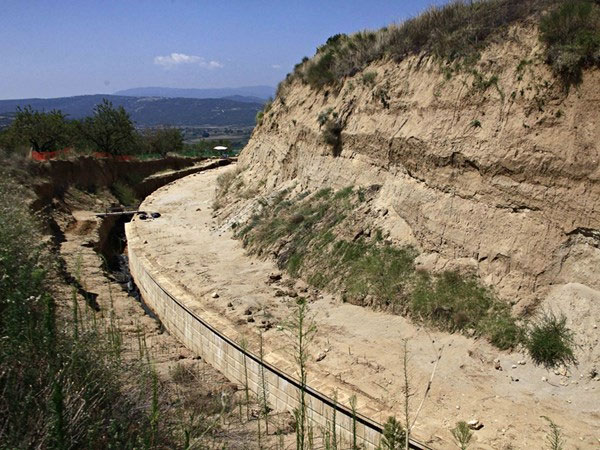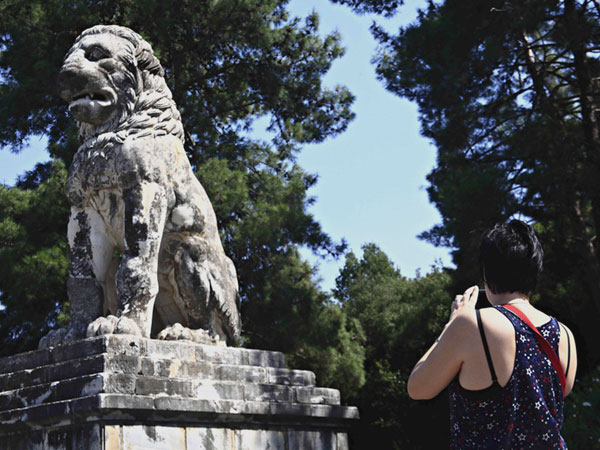Excavation of the grave involves Alexander the Great in Greece
Archaeologists in Greece believe that the large grave they discovered was related to Alexander the Great - who led his army of warriors to conquer large areas of the ancient world between Greece and India.
>>>Found Alexander Alexander's tomb?
The tomb dates back to about 300 BC, and may have been created to preserve the body of one of Alexander General's generals, or some member of his family, beneath a mound Large soil near the ancient Amphipolis area in northern Greece.

The large hill, which is being excavated by archaeologists, is near the ancient city of Amphipolis.(Photo: GETTY IMAGES / Thinkstock)
On 12/8, Greek Prime Minister Antonis Samaras visited the scene where archaeologists are excavating this ancient tomb. He described tomb discovery "obviously very important".
A 5-yard road leads to the tomb, at the top of the entrance there are 2 Sphinx-shaped sculptures, surrounded by a 500-meter-long marble wall. Experts believe that a 16-foot tall lion sculpture that has been discovered nearby can be placed on top of the grave.
They excluded the possibility that this tomb was of Alexander the Great - this king was thought to have been buried in Egypt, after his death due to a fever in Babylon in 323 BC (BC).

A tourist is taking a picture of a marble stone monument in the 4th century BC called Amphipolis, about 5km from a large hill excavated by Greek archaeologists.
The tomb is found in the northern region of Macedonia in the Greek territory, where Alexander began building his empire.
"The land of Macedonia continues to change, which surprised us, what revealed from its deep inside unique treasures combined into a unique picture of Greek history, making all Greeks very self-confident. Prime Minister, Samaras said. Archaeologists have begun excavating the site since 2012. They hope to fully explore the graves by the end of August 2014, pinpointing exactly who was buried there. This place is being carefully guarded by the police.

Police on the area protection fence are being excavated.
Catherine Peristeri - head of the Ancient Monuments Management Agency in northern Greece, said that some of Alexander's generals and admirals were involved in the areas around Amphipolis. This is also the place where Roxana - Alexander's wife and the king's son were executed in 311 BC at Cassander's command - a rebellious Macedonian general in the empire after the death of Alexander the Great.
Located about 100km northeast of Thessaloniki - Greece's second largest city, this ancient tomb is the largest ever discovered in Greece, and probably belongs to "a prominent Macedonian of that time." " , according to an official of the Greek Ministry of Culture.
At the excavation site, archaeologists found many tombs, marble structures and decorative frescoes on white walls, which were partially destroyed during the Roman occupation. close Greece.
Amphipolis was founded in 437 BC, was a colony of Athens, but was conquered in 357 BC by King Philip II of Macedonia - Alexander's father.

The photo captures a portrait of Alexander the Great painted by the latter.
Alexander the Great changed the history of the ancient world at a speed of rapid conquest, and died of illness caught in such a conquest, when he was not 30 years old.
- Solution to the mysterious 2,000 years of Alexander the Great's death
- Alexander the Great was poisoned by the Styx River?
- Discovered two female statues in the Amphipolis tomb area
- The lesson from Alexander the last wish
- Found the tomb of Alexander the Great?
- The remains of Father Alexander the Great have been found
- The 'deadly' weapon nearly destroyed Alexander the Great's army
- Looking to find Alexander the Great Tomb?
- 'Cao Cao Tomb' is not Cao Cao grave?
- The king is proud to conquer more than 5 million km2 on 3 continents
- New assumptions about the relics of Alexander the Great?
- Zigzag art in ancient tombs in Greece
 Discovered an ancient centipede fossil 99 million years old
Discovered an ancient centipede fossil 99 million years old Discovered bat-like dinosaurs in China
Discovered bat-like dinosaurs in China Discovered a 200-year-old bronze cannon of the coast
Discovered a 200-year-old bronze cannon of the coast Discover 305 million-year-old spider fossils
Discover 305 million-year-old spider fossils